![]() More
about the Roman snail's reproduction.
More
about the Roman snail's reproduction.
![]() More
about the Roman snail's genital apparatus.
More
about the Roman snail's genital apparatus.
As variable as the large group of gastropods is, as various are their reproduction strategies. In a special way, the different kinds of marine gastropods, assembled in the "Prosobranchia" group in outdated literature, have to be put against the opisthobranch gastropods (Opisthobranchia) and the lung snails (Pulmonata), which are found on land and in fresh water.
The transition on dry land in the evolution of gastropods could only become possible after numerous adaptations. Marine gastropods strongly depend on the surrounding water specially during mating and the dispersal of larvae. For gastropod life on dry land to be possible, this was what new strategies had to evolve for.
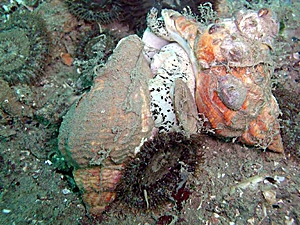 Whelks (Buccinum undatum) mating. Picture: Paul Newland, Marine Life Network. |
Even if the groups of prosobranch gastropods are placed to form independent separate groups, most of them have in common to have separate sexes, which means there are males and females with different sexual organs: The snail's gonad either produces egg cells or sperm cells.
In contrary to this there are, for example, the terrestrial pulmonate snails (Stylommatophora), the gastropod group richest in species, have in common to be hermaphrodites, which have one common genital apparatus with male, female and hermaphroditic organs. Terrestrial pulmonate snails have a hermaphroditic gonad producing egg cells as well as sperm cells. In a Roman snail's hermaphroditic gland, however, this happens at different times, so there can be no self-fertilization. On the other hand this exactly is what may happen in other snail groups (see below).
This is the place to explicitly use the term "terrestrial pulmonate snails", as there are other terrestrial snail species that are counted systematically among a group of prosobranchs, and which, in contrary to terrestrial pulmonate snails possess a shell lid (operculum) and separate sexes. Among those are the terrestrial operculate snails (Pomatiasidae).
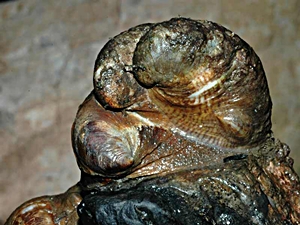 Slipper limpets (Crepidula fornicata) mating. Picture: Keith Hiscock, Marine Life Network. |
While most snails have definite separate sexes, or in case of the terrestrial pulmonates, generally are hermaphrodites, it may also happen in some species that the sex changes during the lifetime. So slipper limpets (Crepidula fornicata) are mobile males in the beginning of their life and change into sessile females at a later time. That is how the spectacular mating "ladders" of slipper limpets come into existence, when younger males sit on older females to mate with them, with even younger males mating with them later, when they are females. A similar development takes place among violet snails (Janthinidae), which are males first and females later, though there is no sessile phase in their life.
Like already mentioned above, concerning snails there must be made a distinction between sexual and asexual reproduction. There is the faulty assumption that terrestrial pulmonate snails, being hermaphrodites, automatically are capable of auto- or self-fertilization. But among many hermaphroditic snails, such as the Roman snail, there is protandry, which means the sperm cells develop a lot earlier than the egg cells, so they are not present any more, when fertilization takes place. That way, it is certain that fertilization takes place exclusively with foreign sperm cells.
Research of related tree snails (Arianta arbustorum) has also led to the result that sperm cells are hindered from fertilizing own egg cells before reaching the sperm pouch (see below) by a special sheath covering the sperm cell's head.
![]() Bild der Wissenschaft: "Safer Sex bei der Schnirkelschnecke" (02.03.2001).
Bild der Wissenschaft: "Safer Sex bei der Schnirkelschnecke" (02.03.2001).
![]() Publications of Dr. Martin Haase.
Publications of Dr. Martin Haase.
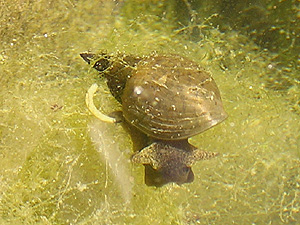 Common pond snail (Lymnaea stagnalis). [RN] |
Things are different in pond snails (Lymnaeidae). Pond snails definitively are able to perform auto-fertilization, a strategy mainly applied when they populate a new water body, which means a small population size has to be increased. Actually the only thing auto-fertilization can do is increase a population's size. Contrary to that, sexual fertilization makes possible the recombination of paternal genes leading to evolutionary change.
 Roman snails mating. [RN] |
Mating strategies among snails are especially different and very much dependent on habitat and environment. Water snails often can use the water as a transfer medium, meaning the sperm cells reach the female's genital apparatus on their own. This method is applied, for example, among violet snails (Janthinidae), whose males are aphallous, they do not possess a penis. In terrestrial pulmonate snails, sperm cells are transferred in a specially built sperm packet, the spermatophore. Copulation not only takes place mutually, the snails being males and females at once, but can also take place at the same time.
In the Roman snail, fertilization takes place separated from copulation by a larger span of time. The sperm cells the snail has received during several copulations are collected in a sperm pouch (Receptaculum seminis or spermatheca) and then are used for fertilization, in competition to each other.
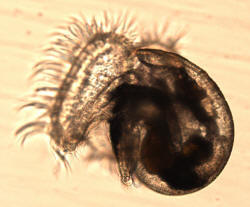
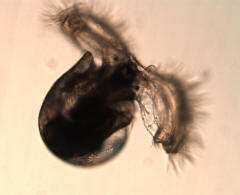 Veliger larvae of a marine gastropod (Kelletia kelletii). Source: Diana Lloyd. |
After the egg cell has been fertilized, it begins to develop into a larva, dispersed through the water as part of the plankton. In molluscs, as in segmented worms (Annelida), the first larval stage is the so-called trochophora.
![]() Wikipedia:
Trochophora
Larva.
Wikipedia:
Trochophora
Larva.
From this, an older larval stage develops, which is uniquely typical for molluscs. Because of their sail-like ciliate appendages those molluscs' larvae are referred to as veliger (sail-bearer).
Snails' veliger larvae already have primordial organs of an adult snail, such as eyes, tentacle stumps and the shell lid (operculum). There is also a shell, which is reduced later in shell-less (slug) species.
![]() Wikipedia:
Veliger Larva.
Wikipedia:
Veliger Larva.
After a metamorphosis, the larva changes into a juvenile snail, which is different from the adult one mainly by having underdeveloped genital organs and a soft translucent shell.
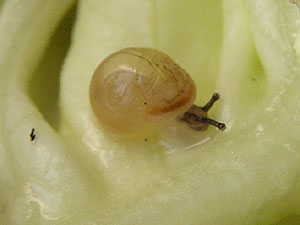 This freshly hatched Roman snail still has got a soft shell, in which lime has to be accumulated. [RN] |
Only later the juvenile snail manages to harden its shell by accumulating lime, to achieve a shell so hard, that the hardness of helmet shells (Cassidae) or conches (Strombidae) only can be imitated with great effort by modern material research.
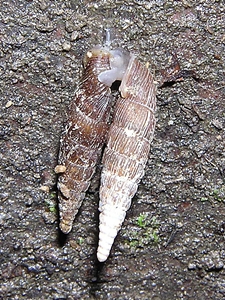 Common door snail (Alinda biplicata) mating. [RN] |
A development passing a larval stage swimming or floating planktontically is of course impossible for terrestrial snails, as there is no water as medium of dispersal. That is why the larval development of terrestrial pulmonate snails takes place inside the egg, from which complete juvenile snails finally hatch.
It may happen, as well among marine gastropods (Janthinidae), fresh water gastropods (Viviparidae) or terrestrial gastropods (Clausiliidae), that oviposition (egg laying) is delayed, until the juveniles hatch inside the mother's body and are born alive. This process is referred to as ovovivipary, as a special case of vivipary (living birth), because there is an egg the juvenile hatches from, albeit inside the mother's body, in contrary to real vivipary, as in mammals. The mud snail family's scientific name Viviparidae is due to their being ovoviviparous.
While ovoviviparous terrestrial and fresh water snails give birth to juvenile snails, the violet snail (Janthina janthina) gives birth to fully developed veliger larvae. In some door snail species (such as the common door snail, Alinda biplicata), there is not necessarily ovovivipary, there may be eggs laid in a normal fashion, depending on the environmental conditions.